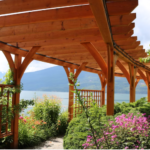In an increasingly urbanized world, biophilic landscaping has emerged as a powerful way to reconnect with nature, improve well-being, and enhance our surroundings. Biophilic landscaping for your backyard is more than just traditional gardening; it’s a deliberate and thoughtful approach to designing outdoor spaces that foster a deep connection between humans and the natural world. This article will explore the principles of biophilic landscaping, focusing on its three core pillars of design.
1. Incorporating Nature’s Elements
Biophilic landscaping begins with a fundamental principle: including natural elements in the design. These elements are essential for creating landscaping in your backyard that resonates with our innate connection to the natural world. Here are some key components:
- Water Features: The sound and sight of flowing water, whether from a tranquil pond, a babbling brook, or a cascading waterfall, evoke a sense of calm and relaxation. Water features can be incorporated into biophilic landscapes to create focal points that attract both the eye and the ear.
- Plant Life: A diverse range of plant species, including native plants, trees, shrubs, and ground cover, are central to biophilic landscaping. These plants provide visual appeal, support local ecosystems, attract wildlife, and improve air quality. Native plants are particularly important, as they are adapted to the local climate and require less maintenance.
- Natural Materials: The use of natural materials such as stone, wood, and organic textiles adds a tactile and sensory dimension to biophilic landscapes. These materials can be used in pathways, seating areas, and architectural elements, creating a seamless connection between the built environment and the natural surroundings.
- Light and Shadow: Sunlight filtering through leaves, dappled shade, and the changing play of light and shadow throughout the day are integral to biophilic landscaping. Design elements that take advantage of these natural lighting effects create dynamic and visually engaging outdoor spaces.
- Wildlife Habitat: Biophilic landscaping embraces the idea of creating a habitat for wildlife. Bird feeders, birdhouses, butterfly gardens, and pollinator-friendly plants attract and support local fauna, fostering a sense of coexistence with nature.
2. Sensory Engagement
Biophilic landscaping seeks to engage all the senses to create a multi-dimensional experience that deepens our connection to the natural world. Here’s how sensory engagement is integrated into the design:
- Sight: Visually appealing elements such as lush greenery, colorful flowers, and textured materials capture our attention and provide a sense of visual delight. Strategic placement of focal points and framed views enhances the overall landscape.
- Sound: The sounds of rustling leaves, chirping birds, and trickling water have a calming effect on our senses. Incorporating elements like wind chimes, water features, or strategically placed rocks can amplify these auditory experiences.
- Touch: The tactile qualities of natural materials invite us to interact with our environment. Smooth stones, rough bark, and soft grass provide varied textures that we can physically connect with as we move through the landscape.
- Smell: Fragrant blooms, aromatic herbs, and the earthy scent of soil engage our sense of smell, creating a sensory journey. Scented plants like lavender, rosemary, and jasmine can be strategically planted to enhance the olfactory experience.
- Taste: Edible gardens and fruit-bearing trees allow us to engage our sense of taste. Homegrown vegetables, herbs, and fruits provide a source of fresh and healthy food and encourage a deeper connection to the land.
3. Spatial Design and Flow
Spatial design is the third pillar of biophilic landscaping and focuses on the layout and organization of outdoor spaces to create a sense of harmony and tranquility. Here are key considerations:
- Flow and Circulation: The design should promote movement and exploration. Pathways, walkways, and open spaces should guide people through the landscape, encouraging them to engage with various natural elements along the way.
- Seating and Gathering Areas: Thoughtfully placed seating areas invite people to linger and connect with the environment. These spaces can be strategically located to capture the best views, sounds, and sunlight.
- Retreat and Refuge: Biophilic landscapes should provide quiet reflection and retreat spaces. These areas can include hidden nooks, secluded benches, or intimate garden spaces where individuals can find solitude and contemplation.
- Scale and Proportion: The scale of design elements, such as trees, shrubs, and structures, should harmonize with the surrounding landscape. Well-balanced proportions create a sense of cohesion and balance.
Contact Pyramid Contracting Today
Biophilic landscaping is a holistic approach to outdoor design that prioritizes our innate connection to nature. By incorporating natural elements, engaging the senses, and carefully considering spatial design, biophilic landscapes offer a range of physical, emotional, and psychological benefits. These landscapes provide aesthetic beauty and a deeper sense of well-being, making them an invaluable addition to residential and public spaces.



